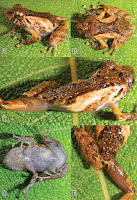Abstract
A new species of frog of the genus Pristimantis is described from a montane forest between 1700 and 1800 m a.s.l. of the Pui Pui Protected Forest (Región Junín) in central Peru. Pristimantis ashaninka sp. n. is described based on five adult females (snout–vent length 23.1–26.7 mm) and ten juveniles (snout-vent length 10.6–13.4). It differs from its congeners by having the skin on dorsum shagreen with many conical tubercles giving it a spinose appearance, lacking a tympanum, having groin, anterior and posterior surfaces of thighs uniformly grayish brown, and a pale bronze iris with fine black reticulations, a median reddish hint horizontally across iris, and a black narrow vertical streak from pupil across lower and upper half of iris. Among the Peruvian Pristimantis that lack a tympanum, P. ashaninka sp. n. is morphologically most similar to P. lirellus, P. martiae, and P. rhabdocnemus. However, 16S DNA barcoding revealed clear distinctions between all four species of Pristimantis.
Keywords: Andes, montane forests, anuran diversity, Pristimantis ashaninka new species, Peru
 |
| Figure 2. Life holotype (MUSM 36517, SVL 24.0 mm) of Pristimantis ashaninka sp. n. |
Pristimantis ashaninka sp. n.
Suggested English name: Asháninka Rubber Frog
Suggested Spanish name: Rana cutín asháninka
Pristimantis sp. Pui Pui in Lehr et al. (in press, Fig. 2)
Etymology: The species epithet ashaninka is used in reference to the indigenous people Asháninka who inhabit forests in the Peruvian Regions Huánuco, Junín, Pasco, and Ucayali.
Distribution, natural history, and threat status: Pristimantis ashaninka is only known from the type locality, which is located at the northeastern border of the Pui Pui Protected Forest, ca. 18 km (straight airline) NW of the town of Satipo, Distrito de Pichanaqui, Privincia de Chanchamayo, Región Junín, Peru (Fig. 1). The type locality lies in the valley of a tributary of the Rio Bravo at an elevation between 1700 and 1800 m a.s.l. and can be reached by walking in one and a half day starting at the village of Ayte (11°09‘46.7‘‘S, 74°55‘14‘‘W, 1295 m a.s.l.), which serves as a control station for the administration of the PPPF. The valley is surrounded by steep mountain slopes, which gives it a narrow character. The surrounding mountains are covered by a primary mountain rainforest characterized by 15–20 m high canopy and frequent occurrence of bromeliads, ferns, and epiphytic mosses. The adult specimens of P. ashaninka were collected at night on vegetation up to 150 cm above the ground whereas juveniles occupied lower positions in the vegetation. Other craugastorid species found at the type locality in sympatry with P. ashaninka included Pristimantis cf. albertus, P. bipunctatus (Duellman and Hedges, 2005), P. cruciocularis, P. cf. platydactylus, and Pristimantis sp. nov. According to the sparse data available, we here classify P. ashaninka as “Data Deficient” according to the IUCN red list criteria.
Edgar Lehr and Jiří Moravec. 2017. A New Species of Pristimantis (Amphibia, Anura, Craugastoridae) from A Montane Forest of the Pui Pui Protected Forest in central Peru (Región Junín).
ZooKeys. 645; 85-102. DOI: 10.3897/zookeys.645.11221
ZooKeys. 645; 85-102. DOI: 10.3897/zookeys.645.11221




